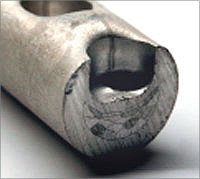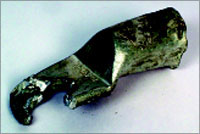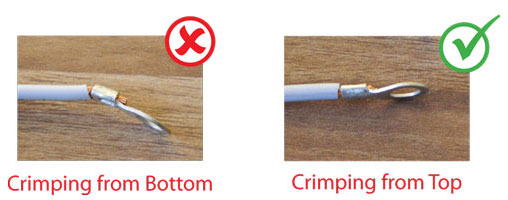
Compound should be freely applied over the stripped portion of wire and also on the inside surface of barrel. Excess compound will seal the barrel mouth after crimping and in turn prevent the ingress of moisture or other contaminated substances present in the surrounding atmosphere.
Compound is recommended to be used when aluminium lug is used with aluminium conductor.
A properly crimped joint is one in which the compressed section of the joint is so tightly packed that it almost becomes homogenous. It can be ascertained by:
Pull Off Load Test - Crimped joint should withstand the pull off load of 4Kg./Sq.mm. Say for 240 Sq.mm. cable, it should withstand 240 X 4 = 960 Kg.
Joint Resistance - As per IS 8337 the resistance of crimped joint on aluminium wire should not be more than the resistance across the length of the conductor equal to the length of barrel of the terminal.
Visual Inspection - Cut a section of the crimped portion and examine the section for air gaps between the conductors, or between the ID wall of the lug and the conductors. Presence of air gaps indicates that the crimping is not homogenous.

NO. The tools designed for Non-insulated terminals will not properly crimp the terminals. It will also damage the insulating sleeve. The same logic applies for insulated terminal also.
The direction of crimping should always be away from the palm portion of the barrel in the case of lugs, and should start from the centre in the case of connectors.

It should be slightly more than the barrel length, which will give the rough idea whether the conductor has been fully inserted or not. However, wherever possible, it is recommended to use the terminals having inspection vent, which will show if the conductor is fully inserted or not.
NO. When the smaller bolt is used with the terminal having higher stud hole, the bolt washer starts forming dish shape while tightening and does not exert proper pressure on the palm. This results in improper contact, which can lead to failure of the termination due to excess heat generation. This is illustrated by the picture below. The electrical contractor in this case had terminated the lug on a fuse gear with a considerably smaller area, resulting in melting of the lug.

When the current flows through any conductive metal, heat is generated. The conducting metal expands when the heat is generated and contracts when the current stops flowing. Spring washer helps in maintaining proper pressure on bolted joints during expansion and contraction.
Our lugs are designed to offer the best possible electrical and mechanical joint. We have found that some electricians and electrical contractors prefer using hammers or pliers to crimp a lug. This technique brought about just to save some expense, is absolutely NOT recommended by us. Mainly because hammering a terminal will not provide the adequate pull-off load strength.

Crimping from the bottom of the lug causes it to deform at the palm portion, which will prevent it from complete contact with busbar upon termination.
